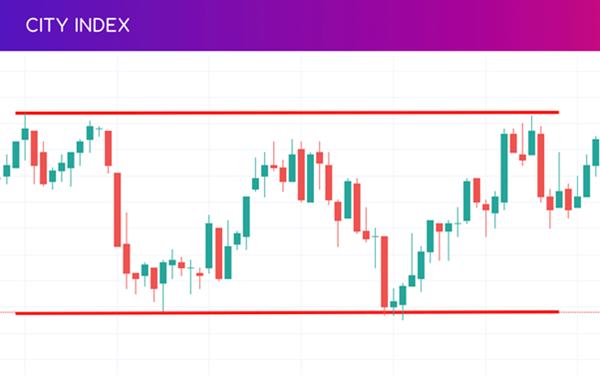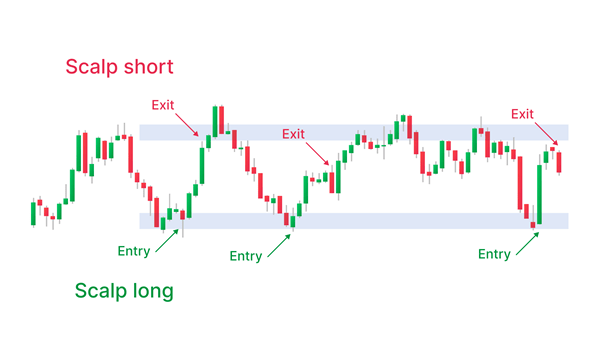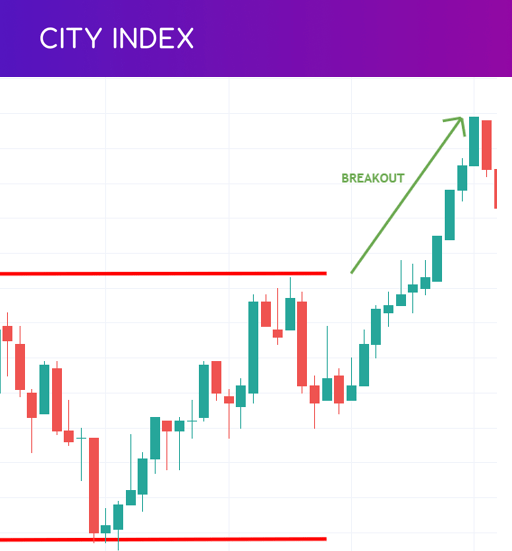
CFDs can be held over different durations depending on your goals. Find out the best long-term and short-term CFD strategies, and which is right for you.
What are CFD strategies?
CFD strategies are guidelines traders use to enter and exit positions. As the name suggests, they’re based on using contracts for difference, derivative products that enable traders to go long and short on financial markets.
This opens up a lot of different opportunities for speculating on rising and falling markets, giving traders a huge range of strategies to choose from.
Learn how to trade CFDs
Most CFD strategies can be used across any timeframe, but some are more popular over the short term, and others better for longer-term traders.
Let’s take a look at each category.
Short-term CFD strategies
Daily CFDs don’t have expiry dates, so are perfect for taking a short-term position – in fact, the majority of traders won’t ever leave a position open beyond the day’s market close. This is called day trading. Whether traders subscribe to scalping or swing trading styles, they’re more likely than not still day traders.
The main reason for this is that CFDs have overnight charges for leaving trades open beyond the market close.
Short-term CFD strategies involve opening positions and holding them for mere seconds up to a day. The aim is to catch profit by identifying smaller but more frequent opportunities within an overarching trend.
These strategies do require more focus, as you’ll be monitoring price charts and using technical analysis to identify entry and exit points.
Let’s take a look at some of the most popular short-term strategies.
Range trading
A range trading strategy uses support and resistance lines to find levels at which a market reverses.
In trending markets, prices break above and below these points. But in a rangebound market, the price rebounds between these two levels, creating a sideways move.

For short-term CFD traders, rangebound markets create the opportunity to scalp profits or swing trade off very small price movements. They’d open a position and hold it just long enough to earn a profit from the move and exit it before the exhaustion level is hit.
It’s common to use momentum indicators to find the points in a trend where the movement weakens, as this indicates the price action will soon reverse.
News trading CFDs
News trading is another common short-term CFD strategy which involves taking advantage of volatility around economic announcements.
This is one of the more fundamentals-focused strategies, as it involves keeping up to date with news and looking at the historical market reaction to similar events.
For the most part, news trading strategies are focused on larger, macroeconomic events – such as interest rate announcements and data releases – because the dates are released ahead of time and the outcomes are easier to predict than breaking news events that take the market by surprise.
Rather than the individual indicators, a news trading strategy’s greatest tool is a good economic calendar. This will help formulate the basis for timings.
This is a short-term CFD strategy because prices tend to move differently immediately following news events than they do over their long-term trajectory. For example, say the ECB announces rate hikes, it could cause EUR/USD to drop temporarily. Or, news following an Australia Reserve Bank meeting may cause the AUD/USD to drop in value for a few hours before continuing a broader uptrend.
Hedging CFDs
Hedging is a popular risk-management CFD strategy which involves opening one or more positions that offset – as much as possible – the risk to an existing trade.
Hedging with CFDs is popular because they can be used to trade rising and falling markets. This means that investors can open a short position on a stock that they own. Hedging could also be used over the long term, but it’s more commonly employed to mitigate losses over smaller timeframes.
Say you owned 100 Apple shares. You believe in the company long term, but think an upcoming earnings announcement is going to negatively impact your position. Instead of taking the temporary loss, you decide to open a hedge. You open a short position on 100 Apple CFDs.
If Apple shares do fall, you can close your CFD trade and take the profit, which would mitigate some of the loss to your original investment position.
However, if Apple shares increased instead, you’d make a loss on your short CFD position, which would eat into the profits of your original investment position.
Long-term CFD strategies
CFD traders looking to take a longer-term position will generally be combining technical analysis and fundamental analysis to get a broader understanding of what’s impacting a market’s price. They’re looking to take advantage of bigger trends, rather than short-term price movements.
The style of trading that best fits long-term CFD strategies is position trading, which is the most similar to investing. However, while investors might hold a trade open for months or years, for traders the duration is more likely weeks to months.
Strategies that position traders use are more passive and trend following. They’ll be looking to open a trade at the start of a trend – or as near to it as possible – then they’ll take advantage of the body of movement and exit it before it reverses.
It’s important to note that the longer-term CFD strategies can be used as a short-term strategy too, all that would change is the price chart period you’re looking at to do any analysis.
Here are some of the CFD trading strategies preferred by longer-term traders:
Support and resistance trading strategy
A support and resistance strategy involves using indicators to find points at which the price of an asset is likely to rally upward or fall into a downtrend. These lines are exhaustion points in the market, where buyers refuse to go higher, and sellers refuse to go lower.
We’ve already seen these lines used in a short-term scalping strategy. But long-term CFD traders can use them too – just over a different timescale. They’d open a long position at a known point of support or a short position at a point of resistance. Then, hold their trade until the prevailing direction reverses at a new support or resistance line.

When trying to find these levels, you’ll be looking at historical price action to see where your market has reversed in the past. A lot of support and resistance strategies are based on shorter-term price movements, but for a long-term CFD strategy, you’d just be looking at the exhaustion points that form over weeks or months.
Typically, traders will just draw the lines on their price chart with drawing tools, and then confirm them with momentum indicators which locate where a previous trend loses its strength.
Breakout trading strategy
Breakout trading involves opening a trade as soon as it ‘breaks out’ of known support and resistance levels.
While the strategy above involves trading the swings between these lines, a breakout strategy is based on looking at when the momentum continues through the levels.

Typically, when a support or resistance price is broken, it marks the start of a new trend.
So, just like with our other long-term CFD strategy, you’d be looking to confirm these price points with trend lines and indicators. But instead of looking for exhaustion at these levels, you’re looking for the movement to continue.
Pullback or retracement trading strategy
A pullback, also known as a retracement, is a small movement against the prevailing trend. During a bullish run, this would be a temporary fall in price, and during a bearish run, it would be a temporary price rise.
By watching out for these retracements, a CFD trader can find a more advantageous price to jump into an existing trend at.
But it’s important to confirm the movement is just temporary, not a permanent reversal, or you could find yourself on the wrong side of a trade.
Technical indicators, such as Fibonacci retracements, can help identify whether the change is an ideal entry point or the start of a longer-term reversal.
Are CFDs good for the long term?
CFDs can be a good way of taking a long-term position on an asset if you don’t want to take ownership of the asset.
Unlike other derivatives, such as futures and options, daily CFDs don’t have an expiration date. So, if you are holding a profitable trade, you can keep it open for as long as you want to let the profit run.
However, there are costs and charges involved with holding CFD positions that need to be considered. If you trade a daily CFD, you’d have to pay an overnight funding charge for holding it beyond the close. This daily interest charge is a published rate, so you can always calculate your costs upfront.
But you could also look at forward CFDs, which do have an expiry date but all the costs of holding the trade longer than a day are built in.
So, before you take a position, you need to think about how much capital you’re willing to spend, and that will inform your decision about how long of a CFD strategy you can take.
These longer-term position trading strategies can be a great way for investors to dip their toe into the more speculative side of financial markets, without diving headfirst into day trading.
Learn about the differences between CFDs and share trading.
Plus, you can always practise building a long-term CFD strategy first in a risk-free demo account, before committing any real capital to markets.
Why use a CFD trading strategy?
Using a CFD trading strategy is crucial to success. It allows you to remain focused on your goals and not make spur-of-the-moment decisions based on emotions – such as fear or greed.
Think of a trading strategy as a risk management tool, except the risk is your own trading psychology.
You’ll also be able to measure and compare your outcomes to your intended strategy. This means you’ll be able to improve your performance over time by assessing where your strategy works and where it doesn’t.
Managing your CFD trading risk
Whether you decide to trade CFDs over the long term or short term, it’s important to understand exactly how they work before you open a position.
Discover what CFDs are
As leveraged products, you’ll only need a small initial deposit to open a position, but your profit and loss will be based on the full market exposure. While this means you could be looking at magnified profits, it also could result in magnified loss should your prediction be incorrect.
Most traders will use risk management tools, such as stops and limits, to mitigate this. You can attach these orders directly to your position in your deal ticket.
CFD strategies FAQs
How long can you hold a CFD position?
The duration of a CFD depends on the type of product you use. Daily CFDs have no expiry date, so you can hold them open indefinitely. However, you will be subject to an overnight funding fee for any positions left open after the market closes each day. Forward CFDs have an expiry date, which you’ll be able to see on each market.
Learn more about CFD trading
Is there a CFD time limit?
No, there’s no time limit placed on a daily CFD position. You can hold your trade for just seconds or indefinitely. However, holding a CFD trade open overnight would result in additional charges. Forward CFDs will have a time limit, dictated by their expiry.
Learn how to trade CFDs
What costs will I incur holding a CFD long term?
Holding a CFD open long-term could result in higher costs due to the overnight funding charge – this is an interest payment that will cover the cost of the leverage that you use overnight.
Learn more about the costs of CFD trading
Is CFD trading taxed?
Yes, CFD trading is subject to tax – for the exact details, you’ll need to look up your country’s specific rules around trading profit taxation, as these can vary from location to location. In the UK, for example, CFDs are subject to capital gains tax (CGT) but exempt from stamp duty.










